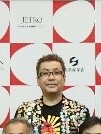Related Research Articles
Events in the year 1948 in Japan.
Tadao Kasami was a noted Japanese information theorist who made significant contributions to error correcting codes. He was the earliest to publish the key ideas for the CYK algorithm, separately discovered by Daniel Younger (1967) and John Cocke (1970).

Tatsuo Itoh was an electrical engineer who was professor and holder of the Northrop Grumman Chair in Microwave and Millimeter Wave Electronics in the Electrical Engineering Department at the University of California, Los Angeles (UCLA), where he taught and conducted research on microwave and millimeter wave electronics, guided wave structures, low power wireless electronics, and integrated passive components and antennas.

Hiroshi Ishiguro is a Japanese engineer and director of the Intelligent Robotics Laboratory, part of the Department of Systems Innovation in the Graduate School of Engineering Science at Osaka University, Japan. A notable development of the laboratory is the Actroid, a humanoid robot with lifelike appearance and visible behaviour such as facial movements.

Tatsuo Kamon, real name Tatsuo Torikai, is a Japanese singer-songwriter born 25 March 1959 in Ibaraki, Osaka Prefecture, Japan. He is represented by the talent management firm Daikan'yama Production, and releases works through Daipro-X, a record company which is a subsidiary of Daikan'yama.

Okaerinasai (おかえりなさい) is the sixth studio album by Japanese singer-songwriter Miyuki Nakajima, released in November 1979.
Ryohei Arai is a Japanese footballer who plays as a defensive midfielder for Sukhothai in the Thai League 1.
Naoki Yokoyama is a Japanese electrical engineer, active in the fields of nanotechnology and electronic and photonic devices, best known for his success in fabricating hot-electron transistors and invention of resonant-tunneling transistors.

The Japan Championships in Athletics is an annual outdoor track and field competition, organized by Japan Association of Athletics Federations. Currently it takes place in June or July. The competition is also for the qualifying trial for the Japanese national team of international competitions.
Arai is a Japanese surname.

Cobalt Hour, stylized as COBALT HOUR, is Yumi Arai's third studio album, released on June 20, 1975 by Toshiba EMI/Express. The album was also distributed by Alfa Records for a period of time, as Alfa also held ancillary rights to this and the other LPs Arai released during the time Alfa was still a publishing company; those rights later reverted to EMI Japan in 1994-thereabouts, when EMI regained distribution of Alfa's catalogue except for the artists who were published by Alfa and were distributed by other labels. On April 26, 2000, the recording was digitally remastered for re-release on CD by Bernie Grundman. Internet sales of the album began March 10, 2005.

Shojiro Nishio is a Japanese information scientist and technology scholar and the 18th president of Osaka University. Having co-authored or co-edited more than 55 books and more than 650 refereed journal or conference papers as well as serving on editorial boards of major information sciences journals, Nishio is considered one of the most prominent and influential researchers on database systems and networks.
Mizuki Arai is a Japanese footballer who plays as a winger for J2 League club Yokohama FC.
Nobukazu Teranishi is a Japanese engineer who researches image sensors, and is known for inventing the pinned photodiode, an important component of modern digital cameras. He was one of four recipients of the 2017 Queen Elizabeth Prize for Engineering. His industrial career wasa at NEC Corporation (1978–2000) and Panasonic Corporation (2000–13). As of 2018, he is a professor at the University of Hyogo and at Shizuoka University.
Tadao Nagatsuma from the Osaka University, Japan was named Fellow of the Institute of Electrical and Electronics Engineers (IEEE) in 2015 for contribution to millimeter and terahertzwave communications using photonics.
Hisao Ishibuchi from the Osaka Prefecture University, Osaka, Japan, was named Fellow of the Institute of Electrical and Electronics Engineers (IEEE) in 2014 for contributions to evolutionary multiobjective optimization and fuzzy rule-based classifier design.
Taiki Arai is a Japanese footballer currently playing as a midfielder for Fujieda MYFC.
Miwako Doi is a Japanese electrical engineer known for her work on user interfaces, robotics, and document processing. She is executive director of the Nara Institute of Science and Technology, executive vice president for data at Tohoku University, auditor of the National Institute of Information and Communications Technology, outside director of the Nomura Research Institute, professor in residence at Osaka University, visiting professor at the Tokyo University of Agriculture and Technology, and a member of the Japan Transport Safety Board.

Hikō-ki Gumo, stylized as HIKŌ-KI GUMO, is the debut studio album by Japanese singer-songwriter Yumi Arai, released in November 1973. The album is most known for its title track.
Hideo Fujiwara is a Japanese computer scientist who made significant contributions to ATPG algorithms. As one of his works, he invented the FAN algorithm in 1983, which was the fastest ATPG algorithm at that time, and was adopted by industry.
References
- ↑ "Tatsuo Arai". osaka-u.ac.jp. Retrieved May 3, 2017.
- ↑ "2016 elevated fellow" (PDF). IEEE Fellows Directory.